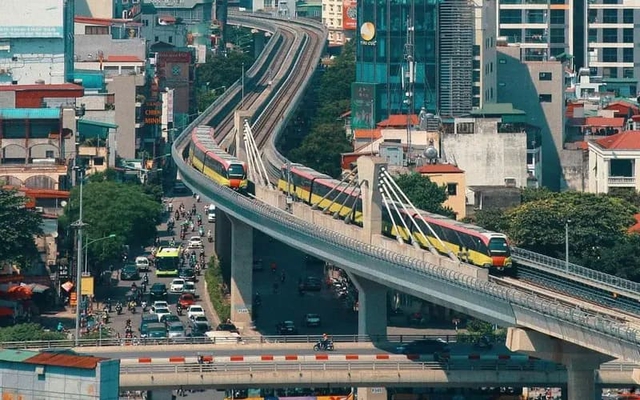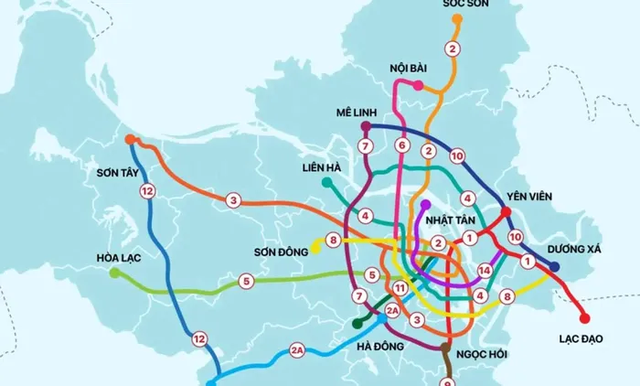Capital shifts from road-based growth to metro corridors
VGP - Ha Noi is redefining its urban future, moving away from decades of road-based expansion toward development centered around rail corridors. The city’s urban railway system is now viewed as a strategic and indispensable foundation for this transformation.

Cities where 40–50 percent of residents rely on public transport save billions of dollars each year through reduced congestion, lower fuel consumption, and cleaner air—while also enhancing labor productivity.
With more than 8.5 million residents and nearly eight million motor vehicles, Ha Noi's transport network has long exceeded its designed capacity.
According to studies by the Japan International Cooperation Agency (JICA) and the Transport Development and Strategy Institute, traffic congestion costs the capital between US$1.2 billion and US$1.5 billion annually—equivalent to 3–5 percent of its gross regional domestic product (GRDP).
The message is clear: without a fundamental shift, Ha Noi could face systemic gridlock within the next decade, even if road expansion continues.

Metro at the Core of Urban Transformation
Globally, no transport mode rivals urban rail in capacity, reliability, and space efficiency. A single metro line can carry between 40,000 and 60,000 passengers per hour in each direction—far surpassing buses or private vehicles.
If Ha Noi successfully implements its ambitious plan to develop 14 metro lines spanning over 400 kilometers, the system could handle up to 45 percent of all urban trips. This would mark a decisive turning point, easing road congestion and reshaping mobility habits across the city.
Metro construction, however, comes at a high cost—ranging from US$150–200 million per kilometer for underground lines and US$80–120 million per kilometer for elevated ones, including trains and equipment. Yet, the long-term benefits are substantial. Cities with strong public transport networks not only save billions annually but also see measurable gains in productivity, environmental quality, and quality of life.
Metro infrastructure also offers the highest social return on investment among transport projects, driving up land value, improving accessibility, and strengthening economic connectivity.
For Ha Noi, the metro is more than just a transit solution—it is the backbone of its future urban structure. Each line and station can anchor new urban centers, commercial districts, administrative hubs, and service zones. This approach supports the city's shift toward a multi-centered model—similar to Tokyo, Seoul, or Paris—helping to reduce pressure on the historic core.
Once completed, the metro network will guide Ha Noi's next stage of growth, forming development clusters along corridors such as Tay Ho Tay–Cau Giay–Ha Dong, Dong Anh–Long Bien–Gia Lam, and Hoa Lac–Xuan Mai.
Over time, metro-led planning—combined with transit-oriented development (TOD)—will help shape a "15-minute city," where residents can access essential services quickly and efficiently, without overloading existing infrastructure.
Urban Restructuring: Overcoming Internal Challenges
Realizing Ha Noi's 14-line metro vision faces several internal challenges—particularly in financing, project management, technology integration, and land clearance.
1. Financing and ODA Dependence
The city's heavy reliance on official development assistance (ODA) has created complex procedural requirements that must comply with both domestic regulations and donor rules. Pilot projects such as Cat Linh–Ha Dong and Nhon–Ha Noi Station revealed cost overruns and delays linked to rigid counterpart funding mechanisms, limited experience with EPC contractors, and weak capacity in contract negotiation and dispute resolution.
To move forward, Ha Noi will need more flexible financing models, reduced dependence on ODA, and greater participation from private investors through public–private partnerships (PPP) and innovative financial instruments.
2. Technology and Operations
Metro systems require seamless integration of track, rolling stock, and signaling infrastructure. However, shortages of skilled engineers, experienced operators, and internationally trained managers have slowed technology transfer and delayed commissioning. Strengthening local technical capacity and ensuring effective system integration are now urgent priorities.
3. Land Clearance and Compensation
Land clearance in densely populated districts remains a persistent bottleneck. New valuation methods that fairly balance the interests of residents and the state are essential. Prolonged clearance delays not only stall construction but also drive up costs through accumulated interest on ODA loans and increased compensation obligations.
Maximizing Impact through TOD
To fully unlock the metro's potential, Ha Noi must integrate transit-oriented development (TOD)—creating dense, mixed-use neighborhoods that cluster housing, commerce, and public services around stations.
TOD zones should cover at least 10 hectares in urban areas and 20 hectares in suburban districts, tailored to local conditions.
A clear legal framework, flexible land valuation policies, and innovative financing tools that capture land value uplift are critical. By recovering part of the increased land value around 10–15 key stations, Ha Noi could fund 20–30 percent of the initial investment for several metro lines.
Finally, metro development must align with a broader urban strategy that encompasses traffic management, vehicle control, multimodal connectivity, and digital operations. These measures should go hand-in-hand with efforts to improve public transport quality and strengthen intermodal connections at each station.
If successfully implemented, Ha Noi's shift from roads to rails will not only relieve chronic congestion but also reshape the capital's urban landscape—ushering in a more sustainable, connected, and livable city for future generations./.

